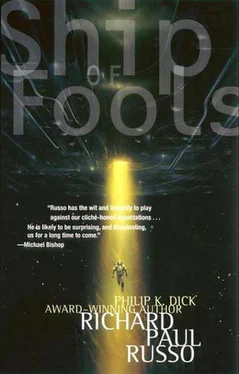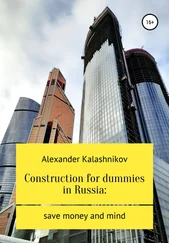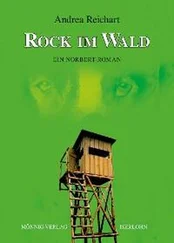“No,” I said. “This is fine.” The truth was I liked it better that way. I was afraid the wonder and mystery would be dispelled by brighter light.
We weren’t very far inside when we entered the spherical chamber I’d seen in Winton’s video. Nylon straps were webbed across the opening through which Santiago had fallen to his death. I drifted over to it, anchored myself, then put one hand through a gap in the webbing. As my hand inched forward, I expected to feel the faint tug of gravity giving it new weight. I felt nothing, and aimed my hand torch through the webbing, playing the beam along the length of the room. It was a long way down.
“I thought there was gravity in here,” I said.
“There is,” Youngman replied.
I reached my hand and arm farther into the room, but still felt nothing. I released the hand torch and it hung in the air by my fingers, drifting slightly but otherwise not moving, and certainly not falling.
“What the hell…?” Winton said.
“How far in does it start?”
“It starts right inside the doorway,” Youngman answered. By then he was beside me, and thrust his own hand and arm through the webbing. “I don’t understand.” He grabbed my hand torch, then gently tossed it toward the far end of the room. It drifted steadily, but never picked up speed, and when it eventually struck the far wall or floor, where Santiago’s body had lain, it bounced off at an angle and headed back to us, though far more slowly now.
“I don’t like this,” Youngman said. “I don’t like this one bit.”
Winton joined us, and, as if to confirm things for herself, inserted her own arm through the webbing, all the way to her shoulder. “What the hell is going on?” she said.
We hovered together around the opening.
“Ideas?” I said.
No one offered any at first, then Youngman said, “Maybe after Santiago fell in, it triggered something, and the gravity got turned off.”
“Except the gravity was still there for days,” Winton pointed out. “Hell, I think it was there the last time I came in here. That was three weeks ago, but still…” She shook her head. “I suppose it’s possible this ship isn’t so dead after all.”
“What?” I said. “There are aliens still alive somewhere, and they’ve switched it off?”
“I don’t know. You have a better idea?”
“No.”
No one spoke, no one offered any answers. Distressed, we moved on.
NOWI saw first-hand what Nikos had tried to explain to me—that there was no evidence of human hand or mind to be seen. We pulled ourselves along corridors far higher and narrower than those on the Argonos ; or far shorter and wider from the alternate perspective. We entered rooms and cabins and chambers unfathomable in design and purpose—devoid of machinery or tools or instruments or furniture, devoid of objects altogether.
There were recognizable doorways, like those of the air lock, with mechanisms workable by human hands encased in pressure suit gloves, but our hands did not fit well around or into those mechanisms, and the necessary actions were often awkward and unnatural.
We saw no signs or labels or other kinds of markings anywhere, nothing with letters, characters, ideographs, nothing to convey a message or notice or identification or warning. If there were any, they were unrecognizable as such, like an alien Braille.
Alien. That’s what that ship was, there was no doubt.
We came to a long, wide room or corridor that corkscrewed several hundred meters deeper into the ship. This was the site of the second and third casualties. The walls were ridged with silver-blue metal ribs that glinted in the lantern light. These ridges were sharper than surgical blades, and when a woman named Zellie Askan pulled herself into the room she brushed against the walls and the fine edges sliced open her pressure suit. Not knowing what had happened, Michael Singer rushed to help her, and contact with the ridges sliced open his suit as well. The cuts in the suits were so numerous, and so long and deep, that repairs were impossible. Within minutes, they both were dead.
Passage through the corkscrew was relatively safe now. A taut cable ran the length of the corridor right down the center. We attached short safety lines from our suits to the cable—the lines didn’t allow enough freedom for us to make contact with the surrounding walls—then pulled ourselves along the cable to the far end.
The rooms and passages in the alien starship were so empty . Barren. It was certainly possible that furniture, appliances, instruments, or other accouterments of daily life had at one time been mounted on the walls, connected to power grids, and could be so again. Perhaps not, perhaps they never had been. Who could say?
I thought about the rooms and cabins on the Argonos , different areas of the ship serving different functions, and I could hardly imagine any of them ever appearing quite so empty without aggressive efforts to strip them bare. Why would we ever want to do that? Why would anyone want to do that?
In the end I was left with a terrible sense of disappointment. I had expected wonders, indecipherable devices, marvelous instruments and tools whose purpose could not be divined, enigmatic chambers filled with artifacts so perplexing yet awe-inspiring, they would leave the mind reeling, overcome by amazement. But the utter emptiness seemed to dispel the wonder that might otherwise have existed.
Near the end of my “tour,” Youngman pointed to the doorway where Goran Durra was killed. After working out the mechanism for the door—a thick, metal panel that slid back into the wall to create an opening—Durra started through the doorway. The metal panel slammed shut on Durra, crushing him. There was no suit rupture, but by the time he was freed and rushed back to the Argonos, he had died of extensive internal bleeding. Now, even though I knew the panel was secure, I pulled myself quickly through the doorway, my stomach tight.
Finally we came to a wide, cylindrical room with coppery walls, entering at what appeared to be the “bottom.”
“This is as far as we’ve explored,” Youngman said. “Sinclair died here.”
“What happened?”
“We don’t know.”
“You don’t know.”
“She was on a team with two others,” Youngman explained. “They’d just worked out the entrance to this room, but they’d been inside this ship for hours at that point, so they decided to hold off, return to the module, then come back later. The other two left first. They hadn’t gone far when they realized Sinclair wasn’t with them. They called to her, but she didn’t respond. When they backtracked, they found her drifting in this room. She was dead. No call, no signal… not a sound.”
“Cause of death?”
“Unknown.”
“Autopsy?”
“They did one. Couldn’t find a thing. She just died. That’s when they decided to suspend exploration for a while.”
“Aren’t you afraid to be here?” I asked.
Youngman shook his head. Winton said, “Not really. That’s why we’re here with you and not someone else.” She smiled at me. “Are you afraid?”
I looked around that coppery, cylindrical room, at what appeared to be another hatch or door at the far end, and thought about the prospect of resuming the exploration of this enormous and mysterious vessel. I tried not to think about the now zero g room or the bishop’s clandestine excursion to this vessel.
“No,” I finally replied. “I’m not afraid.”
There seemed to be nothing else to say. We started back.
LATERthat evening, Cardenas came to my makeshift cabin. I was on my pallet, reviewing the notes I’d made from repeated viewings of the previous excursion recordings. I didn’t expect any new insight or revelation, but it was something to do.
Читать дальше












